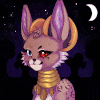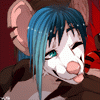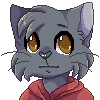
You wouldn't believe what we had as a project from history of animation class.
Our prof asked us what inspired us to become artists, asked us why we like being creative. Then he asked us to put said creativity to the test and that we needed to create a new species of animal. It could be any animal, and we could do it in any medium, but the parameters were that we had to create something new.
literally the anti-Felix Project.
ANYWAYS THOUGH. If I was going to create a new species, I was going to put effort into it.
You don't have to read this all, but I'm going to write a bunch of information about these little guys because THOUGHT and EFFORT.
The Lyte
Genus: Pennaepellis - Meaning derived from feathers/fur/skin
Closest relative: Bats
Habitat: Lytes originate from Madagascar but since humans visited the island, Lyte's got into their bags, onto their boats, and dispersed almost worldwide. The most common Lytes known thus far are the Urban Lyte and the Wild Lyte.
Habitat effects: Depending on where Lytes live, the colours of the flora around them affects their colour points (inner ears, wings and tails on males). If they live around a lot of yellow and white flowers, their colour points will become yellow and white for better camoflauge. This colour development happens over maturity and once they have their colours, they don't change. for this reason, Lytes tend to stay in the same place for their entire lives.
Diet: Lyte's are Frugivores; meaning they only eat fruit. Their favorite fruit to eat is the Pineapple. This fruit isn't commonly had in the wild as it's tough rind is near impossible for Lytes to get through with their tiny claws. Pineapple is actually a human-introduced staple of their diet. Since starting to live with or around humans, Lytes have gained access to pineapple and due to their genetic make up and unique taste buds for fruit, the pineapple has proven to be the most prominent in flavour and is favoured amongst all Lytes.
Reproduction:
Habits:Male Lytes will find females based on the movement, agility and display of his 'air dance'. This is when the male light flies around the female, using his colourful tail much like a ribbon, swinging it around and displaying it to display his colours and strength/health.
Litter Size: Female Lytes can have anywhere from 1-3 Bulbs (babies) at a time, however 1-2 are more common. 3 are very rare and only happen when the environment permits it; e.g. bountiful food, warmer weather with less predation than usual (less stress)
Litter quantity: Females can have one litter per year
Family habits: Lytes will mate for life. One reason for this is that they are extremely social creatures that need to be in the presence of others to lead a happy, healthy life. The other is that due to Lyte's large predation factor, Females will go into heat and give birth once a year (provided they have a mate). The male and female Lyte will take turns looking after the children from week one up until they are old enough to get by on their own. Once Lyte's have mated, they are connected by matching pheromones that only suit each other.
If one mate dies, the other will not seek another partner as their pheromone will not match any other. Instead the remaining Lyte will go into a state of mourning and will become a 'babysitter' of sorts for other Lytes within their community.
Lifespan: Wild Lytes can live anywhere from 7 - 13 years mostly due to having a lrage amount of predators. Urban Lytes can live from 17- 20 years as they have much less to worry about in rural areas. 20 is not unheard of but only a small handful of Lytes have ever been recorded to have lived that long.
Social habits/interaction:Lytes are very social. They live in large communities than can span to up to 100 Lytes all within the same area. This goes for both wild and urban Lytes. In the wild, Lytes gather in low trees or shrubs. In urban areas, they tend to congregate in abandoned buildings
Grooming: Grooming is a very important social staple in the lives of Lytes. These creatures use the digits on their wings to groom each other for at least an hour (or more) a day. This is important for Lytes as it creates a strong sense of safety, family and health for everyone. This way, Lytes become acquainted with the other critters within their same community. As communities grow, it becomes increasingly important to groom. Grooming is not limited to family members grooming family members. Lytes with gather with friends, or even others they don't know yet. Community is important to these critters and trust within the community is essential.
General Anatomy: Lytes do not have a lot of stamina for flight, but sometimes they need to in order to get away from certain ground-bourne predators. For this reason, their lung cavities are exceptionally large to help them with fast getaways and short flights.
Since Lytes grew apart from their bat ancestors, their hind legs grew increasingly strong as these critters took to the ground rather than the sky. These hind legs now are able to carry them at fast speends and are able to turn on a dime. When Lytes run, their ears and wingles (and tails) flatten to create a horizontal line, allowing them to both stay underneath the flora level as well as become more aerodynamic for faster speeds.
As Lytes have very limited dexterity within their fore arms, they use the 3 digits on their wings to complete most dexterous tasks such as opening certain fruits or flowers, holding things and grooming.
In rest position, sitting on their hind legs, Lytes will fold their wing digits together, "holding hands" with themselves. this is both a display of respect and dexterity/health.
Predators: Lytes have an astonishing amount of predators; including but not limited to raccoons, canines, Vulpines, Felines, Predatory birds and more.
Height/weight: Lytes will grow up to 4 inches in height, and weigh up to 37 grams for males and 33 grams for females.
Bulbs are born at 1 inch in height and weigh in at 2 grams.
I have probably forgotten some info, but if you actually read all of that and want to know more, just ask and I will most likely be able to answer as I have put in so much thought into these critters.
But yeah.
School projects woo
what do you think of these fellas? I tried so hard asdfasfsdfadsf
Our prof asked us what inspired us to become artists, asked us why we like being creative. Then he asked us to put said creativity to the test and that we needed to create a new species of animal. It could be any animal, and we could do it in any medium, but the parameters were that we had to create something new.
literally the anti-Felix Project.
ANYWAYS THOUGH. If I was going to create a new species, I was going to put effort into it.
You don't have to read this all, but I'm going to write a bunch of information about these little guys because THOUGHT and EFFORT.
The Lyte
Genus: Pennaepellis - Meaning derived from feathers/fur/skin
Closest relative: Bats
Habitat: Lytes originate from Madagascar but since humans visited the island, Lyte's got into their bags, onto their boats, and dispersed almost worldwide. The most common Lytes known thus far are the Urban Lyte and the Wild Lyte.
Habitat effects: Depending on where Lytes live, the colours of the flora around them affects their colour points (inner ears, wings and tails on males). If they live around a lot of yellow and white flowers, their colour points will become yellow and white for better camoflauge. This colour development happens over maturity and once they have their colours, they don't change. for this reason, Lytes tend to stay in the same place for their entire lives.
Diet: Lyte's are Frugivores; meaning they only eat fruit. Their favorite fruit to eat is the Pineapple. This fruit isn't commonly had in the wild as it's tough rind is near impossible for Lytes to get through with their tiny claws. Pineapple is actually a human-introduced staple of their diet. Since starting to live with or around humans, Lytes have gained access to pineapple and due to their genetic make up and unique taste buds for fruit, the pineapple has proven to be the most prominent in flavour and is favoured amongst all Lytes.
Reproduction:
Habits:Male Lytes will find females based on the movement, agility and display of his 'air dance'. This is when the male light flies around the female, using his colourful tail much like a ribbon, swinging it around and displaying it to display his colours and strength/health.
Litter Size: Female Lytes can have anywhere from 1-3 Bulbs (babies) at a time, however 1-2 are more common. 3 are very rare and only happen when the environment permits it; e.g. bountiful food, warmer weather with less predation than usual (less stress)
Litter quantity: Females can have one litter per year
Family habits: Lytes will mate for life. One reason for this is that they are extremely social creatures that need to be in the presence of others to lead a happy, healthy life. The other is that due to Lyte's large predation factor, Females will go into heat and give birth once a year (provided they have a mate). The male and female Lyte will take turns looking after the children from week one up until they are old enough to get by on their own. Once Lyte's have mated, they are connected by matching pheromones that only suit each other.
If one mate dies, the other will not seek another partner as their pheromone will not match any other. Instead the remaining Lyte will go into a state of mourning and will become a 'babysitter' of sorts for other Lytes within their community.
Lifespan: Wild Lytes can live anywhere from 7 - 13 years mostly due to having a lrage amount of predators. Urban Lytes can live from 17- 20 years as they have much less to worry about in rural areas. 20 is not unheard of but only a small handful of Lytes have ever been recorded to have lived that long.
Social habits/interaction:Lytes are very social. They live in large communities than can span to up to 100 Lytes all within the same area. This goes for both wild and urban Lytes. In the wild, Lytes gather in low trees or shrubs. In urban areas, they tend to congregate in abandoned buildings
Grooming: Grooming is a very important social staple in the lives of Lytes. These creatures use the digits on their wings to groom each other for at least an hour (or more) a day. This is important for Lytes as it creates a strong sense of safety, family and health for everyone. This way, Lytes become acquainted with the other critters within their same community. As communities grow, it becomes increasingly important to groom. Grooming is not limited to family members grooming family members. Lytes with gather with friends, or even others they don't know yet. Community is important to these critters and trust within the community is essential.
General Anatomy: Lytes do not have a lot of stamina for flight, but sometimes they need to in order to get away from certain ground-bourne predators. For this reason, their lung cavities are exceptionally large to help them with fast getaways and short flights.
Since Lytes grew apart from their bat ancestors, their hind legs grew increasingly strong as these critters took to the ground rather than the sky. These hind legs now are able to carry them at fast speends and are able to turn on a dime. When Lytes run, their ears and wingles (and tails) flatten to create a horizontal line, allowing them to both stay underneath the flora level as well as become more aerodynamic for faster speeds.
As Lytes have very limited dexterity within their fore arms, they use the 3 digits on their wings to complete most dexterous tasks such as opening certain fruits or flowers, holding things and grooming.
In rest position, sitting on their hind legs, Lytes will fold their wing digits together, "holding hands" with themselves. this is both a display of respect and dexterity/health.
Predators: Lytes have an astonishing amount of predators; including but not limited to raccoons, canines, Vulpines, Felines, Predatory birds and more.
Height/weight: Lytes will grow up to 4 inches in height, and weigh up to 37 grams for males and 33 grams for females.
Bulbs are born at 1 inch in height and weigh in at 2 grams.
I have probably forgotten some info, but if you actually read all of that and want to know more, just ask and I will most likely be able to answer as I have put in so much thought into these critters.
But yeah.
School projects woo
what do you think of these fellas? I tried so hard asdfasfsdfadsf
Category Artwork (Digital) / Animal related (non-anthro)
Species Mammal (Other)
Size 1189 x 1280px
File Size 452.8 kB
honestly, I didn't plan on making this a species I would sell, or really do anything with. It was just a school project I thought people on here might get a kick out of lol.
I'll probably draw some more on my spare time, mabe I'll design some for others to have but tbh, I'm really not sure. I'm really against OS and OS owners cause I've had so many bad experiences with them xD so I don't want to become what I hate lol
I'll probably draw some more on my spare time, mabe I'll design some for others to have but tbh, I'm really not sure. I'm really against OS and OS owners cause I've had so many bad experiences with them xD so I don't want to become what I hate lol

 FA+
FA+
































Comments